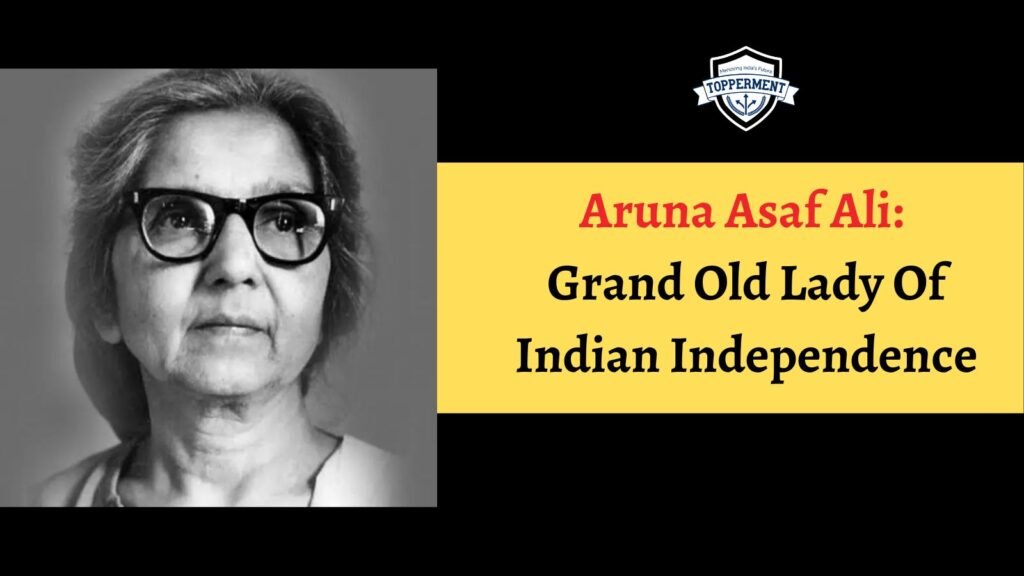Aruna Asaf Ali was a freedom fighter who rose to prominence during the Quit India Movement in 1942. She is known as the ‘Grand Old Lady of Indian Independence’ for her role in the freedom struggle. She was also a doctor, a social worker, a communist leader, and a feminist icon. In this blog post, I will tell you more about her life story, her role in the Indian National Army (INA), her later years, and her legacy.
Aruna Asaf Ali Life Story
Aruna Asaf Ali was born as Aruna Ganguly on 16 July 1909 in Kalka, Punjab, British India (now in Haryana, India). Her parents were S. Swaminathan, a lawyer, and A.V. Ammukutty, a social worker and independence activist. She had a younger sister, Mrinalini Sarabhai, who became a famous dancer. Aruna was very good at studies and wanted to become a doctor. She studied at Queen Mary’s College and Madras Medical College and got her MBBS degree in 1938. She also got a diploma in gynaecology and obstetrics.
She married a pilot named P.K.N. Rao in 1939, but the marriage did not last long. She left for Singapore in 1940 to work as a doctor. There she met some members of the INA, which was an army of Indian soldiers who wanted to fight against the British with the help of the Japanese during World War II. She was impressed by their patriotism and courage.
Aruna Asaf Ali Role in the INA
In 1943, Subhas Chandra Bose, the leader of the INA, came to Singapore and announced his plan to form an all-women regiment in the INA. He wanted women to join the fight for freedom and equality. Aruna Asaf Ali was one of the first women who volunteered to join the regiment. She met Bose and got his permission to set up the regiment, which was named after Rani of Jhansi, a legendary queen who fought against the British in 1857.
Aruna Asaf Ali became Captain Lakshmi and started recruiting other women into the regiment. She trained them in military skills, discipline, and ideology. She also became the Minister of Women’s Affairs in the Provisional Government of Free India, which was formed by Bose in Singapore. The women’s regiment had about 1500 members and they were ready to fight for their motherland.
In 1944, the INA attacked Burma (now Myanmar) along with the Japanese army. They wanted to enter India through the northeast and liberate it from the British. Captain Lakshmi led her regiment in the battle and fought bravely. However, they faced many difficulties and hardships due to lack of supplies, diseases, and enemy attacks. They had to retreat from Burma in 1945.
Captain Lakshmi was captured by the British army in Burma and was taken as a prisoner of war. She was later sent to India to face trial for treason along with other INA leaders. The trial took place at the Red Fort in Delhi and caused a lot of public outrage and sympathy for the INA. Many Indians saw them as heroes and martyrs who sacrificed their lives for freedom. The trial also increased the pressure on the British to leave India.
Literary works:
Aruna Asaf Ali was not only a freedom fighter, but also a writer and publisher. She wrote and edited several literary works, such as:
- The Indian National Army, a book that gives an account of the history and activities of the INA, which she co-authored with her husband Asaf Ali in 1946
- Inquilab, a weekly magazine that she edited while she was in hiding during the Quit India Movement. The magazine was a voice of the underground movement and advocated for revolution and socialism
- Link, a weekly journal that she started in 1950 to propagate her ideas of socialism and reforms. The journal covered various topics such as politics, economics, culture, education, etc
- Patriot, a daily newspaper that she launched in 1965 to support the Left Front and oppose the Congress government. The newspaper was known for its bold and critical views on national and international issues
- Words of Freedom: Ideas of a Nation, a collection of speeches and writings by Subhas Chandra Bose, which she edited and published in 1997. The book pays tribute to her mentor and leader of the INA
Her Later Years
Captain Lakshmi married another INA leader, Colonel Prem Kumar Sahgal, in 1947. They moved from Lahore (now in Pakistan) to Kanpur (in Uttar Pradesh), where she started her medical practice again. She worked among the poor and needy people and provided them free or low-cost treatment. She also joined the Communist Party of India (Marxist) and became involved in various social and political movements.
She fought for the rights of workers, peasants, women, minorities, and other oppressed groups. She also participated in elections several times as a candidate of the Left Front. In 2002, she contested for the post of President of India against A.P.J. Abdul Kalam, but lost by a huge margin.
She continued her work till her last days. She died on 23 July 2012 at the age of 97 in Kanpur.
Titles and Appreciations:
Aruna Asaf Ali was a prominent freedom fighter and political activist who played a vital role in the Quit India Movement of 1942. She was also a pioneer of women’s empowerment and social welfare in independent India. For her remarkable contributions, she received several titles and appreciations from various national and international organizations. Some of them are:
- International Lenin Peace Prize for the year 1964. This award was given by the Soviet Union to individuals who had made significant contributions to the cause of peace, democracy, and human rights. Aruna Asaf Ali was the first Indian woman to receive this honour
- Jawaharlal Nehru Award for International Understanding in 1991. This award was instituted by the Indian Council for Cultural Relations (ICCR) in memory of India’s first Prime Minister, Jawaharlal Nehru. It is given to eminent persons who have promoted international understanding, goodwill, and friendship through their work. Aruna Asaf Ali was one of the recipients of this prestigious award
- Padma Vibhushan in 1992. This is the second-highest civilian award in India, conferred by the President of India for distinguished service of a high order in any field. Aruna Asaf Ali was awarded this honour for her public affairs and social work
- Bharat Ratna posthumously in 1997. This is the highest civilian award in India, bestowed by the President of India for the highest degree of national service. Aruna Asaf Ali was one of the few freedom fighters who were honoured with this award after their death
Apart from these awards, Aruna Asaf Ali was also honoured with a postage stamp issued by the Government of India in 1998, and several roads, institutions, and parks named after her in various cities of India. She is widely regarded as the ‘Grand Old Lady of Indian Independence’ and an inspiration for generations of Indians
Her Legacy
Aruna Asaf Ali is remembered as one of the most inspiring and influential women in Indian history. She is admired for her courage, dedication, compassion, and vision. She is an example of how women can play an important role in nation-building and social change.
She is also honored by various institutions and organizations for her contributions to India’s freedom struggle and development. Some of them are:
- The Rani Lakshmi Bai Central Agricultural University in Jhansi (Uttar Pradesh) is named after her
- The Government General Hospital in Chennai has a statue of her in its premises
- The Indian Postal Department issued a commemorative stamp on her in 2014
- The Sahgal Foundation, a non-governmental organization, works for the empowerment of rural women and children in her name
Also Read
- How does Yoga help students to deal with common problems? | Yoga And Mindfulness
- How does Physical health affect mental health? | Yoga And Mindfulness
Follow Us For More Content On:
https://www.instagram.com/topperment/


